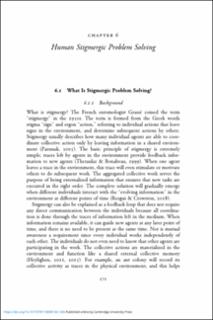| dc.contributor.author | Baltzersen, Rolf K. | |
| dc.date.accessioned | 2022-09-25T22:46:01Z | |
| dc.date.available | 2022-09-25T22:46:01Z | |
| dc.date.issued | 2022 | |
| dc.identifier.uri | https://hdl.handle.net/11250/3021112 | |
| dc.description | Chapter 6 in Cultural-historical perspectives on collective intelligence
In the era of digital communication, collective problem solving is increasingly important. Large groups can now resolve issues together in completely different ways, which has transformed the arts, sciences, business, education, technology, and medicine. Collective intelligence is something we share with animals and is different from machine learning and artificial intelligence. To design and utilize human collective intelligence, we must understand how its problem-solving mechanisms work. From democracy in ancient Athens, through the invention of the printing press, to COVID-19, this book analyzes how humans developed the ability to find solutions together. This wide-ranging, thought-provoking book is a game-changer for those working strategically with collective problem solving within organizations and using a variety of innovative methods. It sheds light on how humans work effectively alongside machines to confront challenges that are more urgent than what humanity has faced before. This title is also available as Open Access on Cambridge Core. | en_US |
| dc.description.abstract | Chapter 6 presents human stigmergic problem solving as a distinct “solution-centered” subtype of CI with biological antecedents in the trail laying and nest building of ants. Stigmergy describe how many individuals agents are able to coordinate collective action only by leaving information in a shared environment. In this type of collective problem solving, a version of a solution will already exist, either partially or completely. The problem-solving process will, therefore, be a response that changes the existing version of a solution by rating it like with an online video, re-estimating it through a prediction market, adapting it like an open textbook or completing it like a Wikipedia article. In human qualitative stigmergy, a preliminary part of a solution will be stored in the system or medium, and individuals will then respond to the unfinishedness in the solution in different ways. If many versions of a solutions already exist, human quantitative stigmergy can also be used to rate the most optimal solutions. In the online setting, solutions will be continuously compared with each other. These stored solutions also solve many different problems at various points of time. | en_US |
| dc.language.iso | eng | en_US |
| dc.publisher | Cambridge University Press | en_US |
| dc.rights | Attribution-NonCommercial-NoDerivatives 4.0 Internasjonal | * |
| dc.rights.uri | http://creativecommons.org/licenses/by-nc-nd/4.0/deed.no | * |
| dc.subject | Quantitative Stigmergy | en_US |
| dc.subject | Quantitative Stigmergy | en_US |
| dc.subject | Sematectonic Stigmergy | en_US |
| dc.subject | Marker-based Stigmergy | en_US |
| dc.subject | Solution-centeredness | en_US |
| dc.subject | Rating Complete Solutions | en_US |
| dc.subject | Search Engines | en_US |
| dc.subject | Collaborative Filtering | en_US |
| dc.subject | Rating methods | en_US |
| dc.subject | Reestimating Solutions | en_US |
| dc.subject | Completing Solutions | en_US |
| dc.subject | Filling in missing parts | en_US |
| dc.subject | Adapting solutions | en_US |
| dc.subject | Open textbooks | en_US |
| dc.subject | Internet memes | en_US |
| dc.title | Human Stigmergic Problem Solving | en_US |
| dc.type | Chapter | en_US |
| dc.description.version | publishedVersion | en_US |
| dc.rights.holder | Rolf K. Baltzersen | en_US |
| dc.source.pagenumber | pp 171-207 | en_US |
| dc.identifier.doi | 10.1017/9781108981361.006 | |

